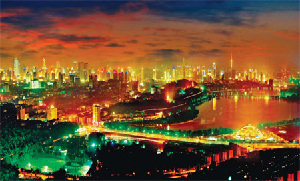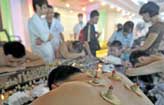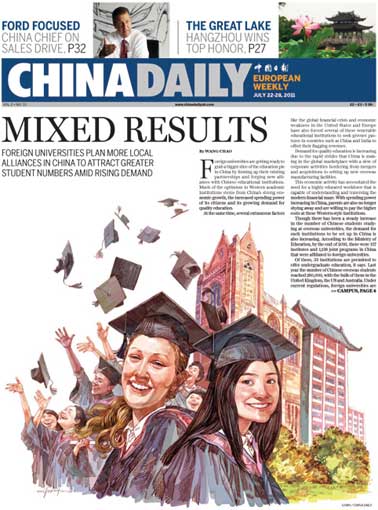The tusk at hand
Updated: 2011-07-01 10:46
By Liu Lu (China Daily European Weekly)
 |
|
Auction houses are expectng the price of ivory carvings to increase by 20 percent this year compared to last year. Hu Xuebo / for China Daily |
IIvory carving prices zoom as demand from rich chinese collectors peaks
Carving has thrived in China for thousands of years and artists demonstrated their superb craftsmanship and creativity using anything they could get their hands on. Jade, ivory, stone, wood, bamboo, nutshells, animal horns and bones were all used to create wonderful works of art. But for the royal family, the most treasured carvings were made from ivory, which was associated with elegance and nobility and always served as a tribute to the emperor.
Today, the demand for antique ivory carvings is rising, and so is the price, thanks to mounting number of rich Chinese collectors who are paying tens of thousands of euros for these rare works.
Last year a 38cm-tall, delicately carved Buddha, crafted during the Qing Dynasty (1644-1911), sold for 400,000 yuan (43,700 euros), however this year the same statue is expected to sell for more than 600,000 yuan.
"Generally speaking, the price of ivory carvings in the auction market this year is expected to increase by 20 percent compared to last year," says Chen Ketao, vice president of Shanghai Association of Collectors.
Chen expects more ivory treasures, some crafted in China centuries ago, to return to his homeland this year because of demand and higher prices. And now, new ivory works are being added to the market after almost two decades of very little production.
The worldwide ban on ivory trade in 1989 halted elephant poaching, but dealt a heavy blow to ivory craftsmen. In the 1980s, ivory carving was a major industry in Beijing, and the capital's largest ivory factory employed more than 800 craftsmen and staff. By 1992, there were only 80 workers left at the factory.
In 2008, when China was allowed to buy ivory from the government stockpiles of four African countries, the nation's craftsmen got busy working on new designs and supplying the hungry market with a fresh batch of artworks.
"Ivory carving has a more bullish market outlook and prices have been steadily rising over recent years," says Ding Qinfen, 62, a Beijing art dealer and experienced ivory carver.
In his small workshop of less than 10 square meters, a number of exquisite ivory pieces are on display. His largest piece is a 1-meter-long elephant tusk, which features meticulously carved miniatures of Chinese-style homes, temples and people. The smallest item is a rose-shaped ring.
To establish ivory quality, Ding examines each piece under ultra-violet light.
Ding says elephant tusk ivory often comes in the largest pieces and is relatively soft and even, making it ideal for carving, however, it is the most expensive.
Since 2009, ivory carvings have become increasingly popular at auctions, says Wang Jing, manager of the auction department of China Guardian Auctions Co Ltd, one of China's earliest auction companies specializing in Chinese artwork.
Between 1994 and 2011, the company auctioned 2,316 pieces of ivory items and about 81 percent of the stock was sold achieving a turnover of more than 75 million yuan.
Wang says the most in-demand ivory works were made during the Qing Dynasty.
"These antique pieces, which demonstrate an extremely high level of precision of carving and incomparable detail, are very valuable in the auction market," Wang says. He says experienced art collectors predict the market will usher in a new round of price increases in the coming years.
China's major ivory carving centers are Beijing, Guangzhou and Shanghai and each city has its own speciality.
Beijing is famous for its human figures, flowers and birds. Guangzhou is well-known for its exquisitely carved ivory balls and Shanghai is famed for its delicate figures.
"Its smooth feel and the lovely sheen and color that comes with aging, makes carved ivory a favorite for collectors around the world," Chen says.
To measure the value of each ivory piece, its manufacturing date, craftsmanship, texture, and the maker's reputation all come into the equation.
Generally speaking, Chen says, the older the piece, the higher its price.
"Carved ivory is not only a special material, it also has cultural value," says Chen.
In Chinese culture, an elephant is an auspicious omen because the word for this big animal is xiang, which sounds similar to xiang in the phrase jixiang, meaning lucky fortune, according to Wang Shan, secretary general of the China Arts and Crafts Association, and leader of the affiliated China Ivory Carving Association.
For this reason, ivory products were in big demand during this year's Spring Festival because they were considered a lucky gift.
And because of the fresh supply of ivory, there were more products on the market. There is also a new generation of carvers taking up the craft.
Last year, the Beijing Ivory Carving Factory hired new junior members to carry on the tradition. It was the first time in more than 20 years the factory had recruited apprentices.
In 2006, ivory carving was listed on Beijing's Intangible Cultural Heritage register and the ivory factory received government subsidies to hire new employees.
Most of the new recruits, a majority in their 20s, were attracted by media reports, saying the craftsmanship of ivory carving is facing extinction and that the factory needed staff.
Head of the factory, Xiao Guangyi, says the number of craftsmen is diminishing with most nearing retirement age.
Xiao says there are some masters who are still carving past the age of 80, but it is vital that new people learn the craft.
"Ivory carving is in danger of being extinct if no one new wants to learn it," Xiao says.
Expert carvers say it takes about eight years to master the craft, and the factory's new recruits have enough material, thanks to the reversal of the ban in 2008.
The 61 tons of ivory imported from Africa is expected to cover the market for nine years but not everybody in China is happy with the ivory boom and animal protection activists are calling for the ivory trade to stop.
He Yong, an officer from the International Fund for Animal Welfare (IFAW), is calling for a complete ivory ban because the demand is encouraging illegal poaching. The number of elephants in Africa has shrunk to 470,000 from 1 million only 20 years ago, he says.
In Beijing's subway stations, IFAW has put up posters urging people to stop buying ivory goods.
"Saving a lost art should not be at the cost of killing endangered animals," he says.
E-paper

Ringing success
Domestic firms make hay as shopping spree by middle class consumers keeps cash registers ringing in Nanjing
Mixed Results
Crowning achievement
Living happily ever after
Specials

Ciao, Yao
Yao Ming announced his retirement from basketball, staging an emotional end to a glorious career.

Going the distance
British fitness coach comes to terms with tragedy through life changes

Turning up the heat
Traditional Chinese medicine using moxa, or mugwort herb, is once again becoming fashionable
